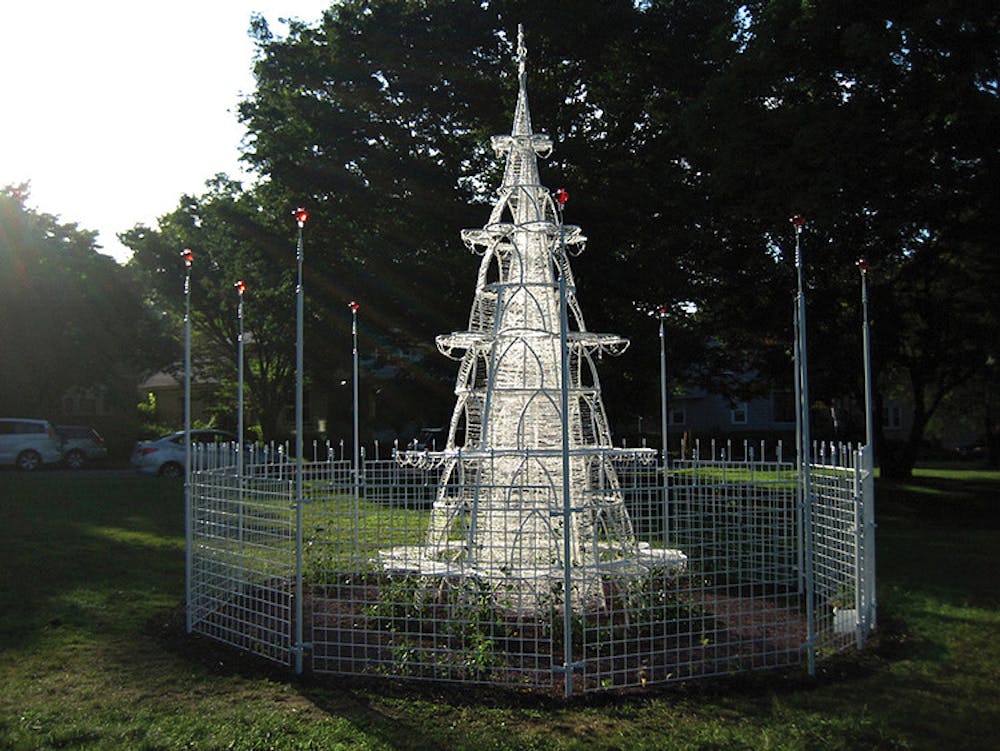Dazzlingly white, the Hummingbird Palace points skyward like an incandescent Christmas tree, perhaps bringing to mind something found in a shopping mall during a more festive season. But it’s Hope Street’s Lippitt Park, not Providence Place Mall, that is the home of local artist Esther Solondz’s recently installed sculpture — a symbol of neither the religious nor the commercial but instead a place for those looking to celebrate the beautifully fickle distinction between the natural and man-made.
The installation centers around a large inner triangle — the most sturdy part of the piece — consisting of poles wrapped in thread. This internal structure is encapsulated by an open-air arboreal sculpture, which complements the triangle’s simplicity with a complex series of loops dripping with silicon trim, much like the adornments of the aforementioned tree. The two pieces together present a regal package, substantiated further by a surrounding fence punctuated by poles topped with ruby-red hummingbird feeders — guard turrets protecting the titular palace, while also attracting the birds.
Majestic design aside, what brings the piece together are the natural interactions occurring both around and within it. The sculpture is less of a palace for its aesthetics than for its openness, which allows hummingbirds to dart in and out as they please and honeysuckle vines — with red flowers to attract the birds — to worm their way up and around the metal structure.
The work draws from Solondz’s love of working with fragile, impermanent and unpredictable materials, such as salt, rust and soap, she said, adding that in this case, the involvement of plants and animals add the ultimate element of unpredictability, she added. She previously attempted to use seeds from Charles Darwin’s Down House in a piece celebrating the preeminent biologist’s bicentennial, but failed to execute the project, leaving her searching for an opportunity to try again with plants.
Solondz’s enthusiasm for hummingbirds originated while working at her summer home in New Hampshire. She experimented with gradually moving hummingbird feeders closer toward her studio until eventually the hummingbirds were soaring about among her artwork, she said.
In her latest work, Solondz once again incentivizes hummingbirds to roam her art — this time in her larger home of Providence — with the stubborn vine providing the perfect foil for the ephemeral hummingbird.
A graduate of the Rhode Island School of Design, Solondz has strong links to Providence. But her ties to Lippitt Park are even more firmly rooted. About a decade ago, when Solondz’s daughter and a friend were in fifth grade, the pair celebrated a birthday, asking for money to plant trees in the park in lieu of presents, Solondz said. The two weeping cherry trees can now be seen behind the Hummingbird Palace, the older figures standing watch as the recently-planted vines begin their own evolutionary process.
Ten months in the making, the Hummingbird Palace received financial backing from the Rhode Island Council of Arts, as well as philanthropists in the area, Solondz said. The construction itself benefitted from volunteers, who used expertise to weld and extra hands to water, she said.
Months after the work was installed, Solondz and the volunteers still consider the work evolving. After an investigation revealed rabbits as the cause of disappearing flowers, the outside fence was reconfigured. Watering remains a constant endeavor as the flowers take root, and Solondz is even considering whether or not to create a watering mechanism extending from the sculpture, she said. With the flowers finally growing, the group is hoping that more hummingbirds inhabit the space during its sophomore year as hummingbird season rapidly comes to a close.
But regardless of human involvement, Solondz has no doubt that the promise of continual evolution, enshrined on the plaque explaining the Hummingbird Palace, will come true, she said.
Environmentally, Solondz is doing Providence a favor, said Dawn King, visiting assistant professor in the Department of Environmental Studies. Hummingbirds are important pollinators, especially now that pollinating collapse disorder is affecting bees at a rapid rate, King said.
“Interestingly enough, hummingbirds are losing habitat like anybody else due to climate change, but they’re the lucky ones people want to attract to their backyard,” King said. Hummingbirds are unique — besides their metallic sheen and blurred movements, they are the only bird that can fly backward and have perhaps the highest metabolism of any living creature. The hummingbird’s intrigue will provide urban areas not only with aesthetically pleasing bird sightings but also sustained environments for a long time, King said.
-With additional reporting by Emily Dupuis

ADVERTISEMENT




